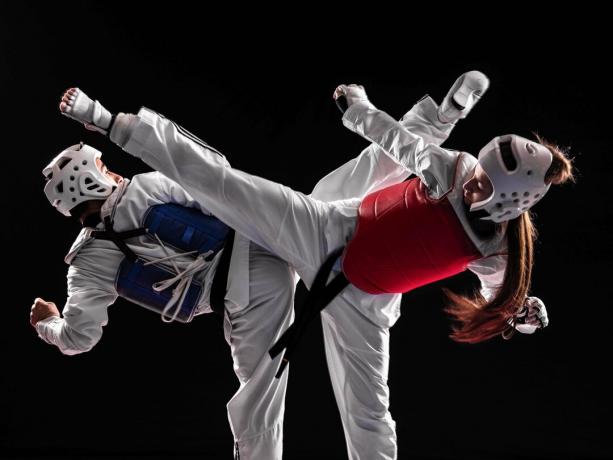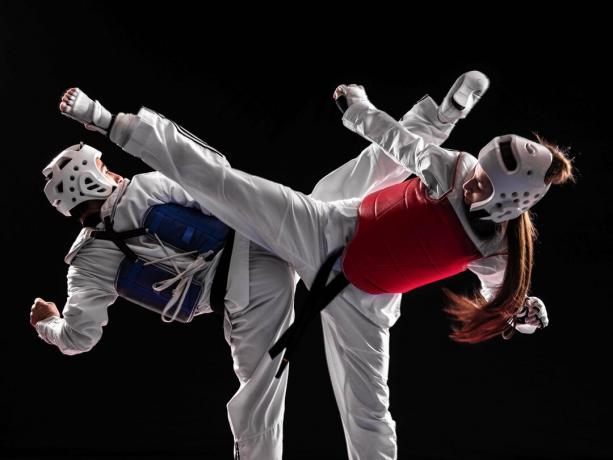Taekwondo, also called Taekwondo or abbreviated as TKD, is a South Korean martial art which has become a combat sport widely spread throughout the world.
It is a set of unarmed combat techniques for self-defense, which include the use of fists and quick, high kicks.
In 1988, it debuted as a demonstration sport at the Seoul Olympic Games. In 2000, it became an official sport of the Olympic Games.

The term "taekwondo" derives from the combination of three Korean ideograms: "tae" + "kwon" + "do".
Tae = Feet
Kwon = Hands
Do = Path
It is, therefore, a martial art that uses only the upper and lower limbs for combat.
History and origin of Taekwondo
The origins of taekwondo date back to era of the Three Kingdoms of Korea (50 a. W. — 668 d. C.), when the warriors of the Silla Dynasty, known as Hwarang, began the development of a martial art called Taekkyon, which emphasized combat techniques with feet and hands, as well as including techniques in grappling (grappling).
During the Japanese occupation of Korea (1910 – 1945), Korean martial arts were banned, but many Koreans continued to practice them secretly.
After World War II, General Choi Hong-hi, a prominent figure in Korean martial arts, worked to unify several martial schools. The initiative culminated in the founding of Kukkiwon on April 11, 1955, becoming the official taekwondo organization.
The martial art quickly gained popularity in South Korea, being recognized as a national sport in 1973. It debuted as a demonstration sport at the Seoul Olympic Games in 1988, becoming official at the Olympic Games in 2000.
It is currently practiced by millions of people around the world, making it a popular martial art for self-defense, fitness, and competition.
Taekwondo rules
Taekwondo rules aim to ensure the safety of competitors and promote fairness in competition.
Some of the fundamental guidelines of the martial art include:
Competitors must wear head, torso, leg and wrist protectors.
Blows can only be struck with permitted areas of the body, such as feet and hands.
It is not allowed to reach below the waist line.
Grabbing or knocking down an opponent is not permitted.
If a competitor is knocked down, they have 10 seconds to get back up.
Points are awarded based on attack techniques, such as kicks, punches and knees, with blows to the head being worth more points than those that hit the torso.
The fights take place on an 8x8 meter mat, with three rounds of 2 minutes each. Points are awarded for attack techniques, with blows to the head scoring higher. Victory can occur by points, knockout or disqualification.
Taekwondo belts (graduation)
Taekwondo practitioners are categorized by belts, representing their skill levels, with colors ranging from white to black.
The white belt is aimed at beginners, covering learning the fundamentals, such as posture, basic movements and self-defense techniques.
The intermediate colored bands symbolize the practitioner's progress, involving the assimilation of more advanced techniques, including kicks, punches and combinations. In sequence, they are: gray, yellow, orange, green, purple, blue, brown, red and black tip red.
The black belt, the highest in taekwondo, is reserved for practitioners considered masters of this martial art. Belt progression requires passing exams that assess the practitioner's knowledge and skills.
Philosophical principles of Taekwondo
Taekwondo is based on five philosophical principles, designed to foster the physical, mental and spiritual development of practitioners. Are they:
Ye Ui(courtesy): plays a vital role in many Asian cultures. In taekwondo, courtesy implies respecting oneself, others and the environment, requiring practitioners to adopt a respectful posture in all situations, including the dojang (taekwondo academy).
Yom Chi(integrity): represents another fundamental principle in taekwondo. Honesty and reliability are essential for practitioners, who must be true to themselves and others.
In Nae(perseverance): is crucial to success in taekwondo. Practitioners need to be willing to dedicate themselves intensely, not giving up on their goals, overcoming challenges and maintaining a continuous commitment to learning and growth.
Gung Gi(self-control): is imperative to avoid injuries and conflicts. Taekwondo practitioners must have the ability to control emotions and actions, using their techniques only for self-defense.
Baekjul Boolgool (indomitable spirit): reflects a courageous and determined mentality. Practitioners need an indomitable spirit to overcome challenges and achieve their goals.
The philosophical principles of taekwondo transcend words, being a lifestyle to be followed by practitioners in all areas of their lives.
Taekwondo in Brazil
Taekwondo was introduced in Brazil in 1970 by master Sang Min Cho, officially sent by the International Taekwondo Federation (WTF) to establish the first school of this martial art in the country.
The sport quickly gained popularity in Brazil, culminating in the sport's first Brazilian championship in 1973. In 1987, the Brazilian Taekwondo Confederation (CBTKD) was founded, assuming responsibility for the administration of the martial art in the country.
Brazil has a notable history of success in international taekwondo, with Brazilian athletes winning several medals in world championships and the Olympic Games.
See too:
martial arts
Kung Fu
Karate
Muay Thai
Boxing
Jiu Jitsu
Capoeira
Meanings: more than a simple encyclopedia. A simple encyclopedia.



